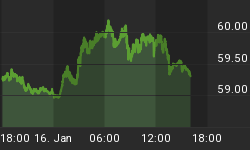To hear the talk from the mainstream press you'd think the dollar's demise was imminent. Everyday is becoming a repetition of a theme that we've actually been hearing off and on since 2004, namely, the collapse of the U.S. dollar. But as we've chronicled here many times in the past, whenever the bearish factor gets a little too loud on the dollar's weakness, a period of stability and/or strength begins. That's exactly the point along the cycle the dollar is in now.
In the past two weeks alone I've heard comments from around the world from friends and colleagues, investors and non-investors alike, who have intimated their view of the dollar. In most cases I didn't even have to ask for their opinion as it was offered full scale as a topic of conversation. That's one sign the dollar's latest decline went too far on the downside.
Another sign that dollar is overdue some stability is the talk I've been hearing among market technicians of an "imminent collapse" below the 80.00 level in the dollar index. I've heard even respectable technicians say words to the effect of, "There is no support for the dollar below 80.00." Oh yeah, says who? Just because there is no trading history below the 80.00 level of the benchmark U.S. dollar index doesn't necessarily mean there is no "support." Support is a function of many things. It's not just a level on a price graph but a trigger for the movers and shakers of the marketplace to step in and prevent major declines from spiraling out of control. Support can *always* be arranged by the powers-that-be at any given time. Never forget that truth.
Currencies are the shooting gallery of the central banks and international financiers and they can step in to provide support whenever they see it necessary. Would now be one of those "necessary" times of support for the U.S. dollar? Indeed it would. After the most recent test of the trading channel lower boundary near the 81.00 level.
Last month when this test of the trading channel was made I wrote, "Support should be encountered in the dollar somewhere between the 80 and 82 levels followed by a period of base building and eventually a reversal of the weakness. Already the dollar index has made a downside 'channel buster' which normally implies exhaustion of the short-term downtrend. The dollar index has made three successive channel busters below the lower boundary of the downtrend channel that has been intact since January of this year....A triple channel buster usually succeeds in at least ending the short-term downtrend."
True enough, a triple channel buster is an even that can't be ignored and it signified the end of the latest decline of the dollar index in April. Notice the updated chart provided below.

After making the third and final channel buster in late April, the dollar has since broken out of its downtrend channel and may be in the process of creating a short-term uptrend channel, although it's still a little early to tell. The important thing to remember is that a pivotal low has been made around the 81.00 level and this will likely be held for now and going into summer. While it's hard to envision a runaway rally in the dollar at this point, it isn't so hard to envision a period of stabilization above the April low lasting for the next several weeks. Investor sentiment is too bearish on the dollar right now and from a contrarian standpoint that's supportive of the dollar. Only when sentiment becomes complacent again can we expect to see any more weakness.
I've been collecting evidence of a short-term reversal of dollar weakness and the evidence has been mounting lately. From the standpoint of market psychology this shows up clearly in newspaper headlines. Here are some recent headlines that suggest, from a contrarian standpoint, that the dollar could strengthen or at least stabilize:
"Faltering U.S. dollar poses a dilemma for equity investors"
"Dollar poised to come under pressure"
"Dollar bills are still looking decidedly crumpled"
"UK exporters curse the weak dollar's drag on profits"
All of these are signs that the currency market comptrollers aren't going to let dollar weakness continue to exert a negative influence on the dollar-sensitive financial sectors much longer.
Another point worth considering is the relationship between the dollar and interest rates. In particular, the 3-month T-Bill Discount Rate can be used as a leading indicator for the direction of the dollar. As Carl Swenlin points out in his Decision Point web site: "The direction of interest rates is an important element affecting the dollar. Rising rates give the dollar strength and falling rates bring weakness. Changes in interest rate trends tend to lead the dollar by about a year."
With T-Bill rates diverging higher from the dollar over the past year, along with other technical divergences, at least a temporary reversal of the dollar downtrend is a strong possibility. The longer-term dollar trend remains down, but a period of near term strength and/or stabilization is a strong likelihood for reasons explained above. As the headline suggested, "The dollar isn't dead yet!"
















